fuel cap CADILLAC SEVILLE 1997 4.G Owners Manual
[x] Cancel search | Manufacturer: CADILLAC, Model Year: 1997, Model line: SEVILLE, Model: CADILLAC SEVILLE 1997 4.GPages: 370, PDF Size: 20.52 MB
Page 143 of 370
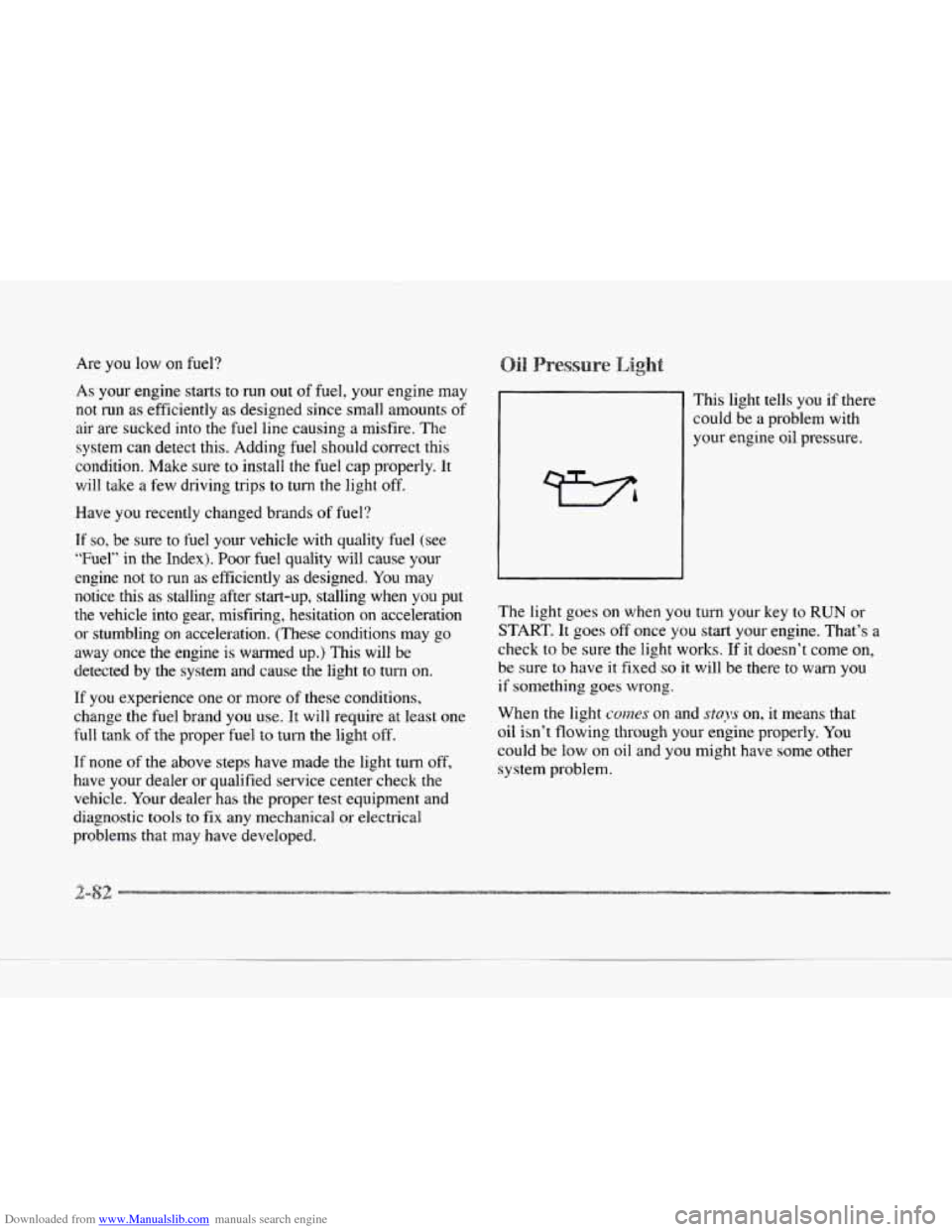
Downloaded from www.Manualslib.com manuals search engine Are you low on fuel?
As your engine starts to run
out of fuel, your engine may
not run as efficiently as designed since small amounts
of
air are sucked into the fuel line causing a misfire. The
system can detect this. Adding fuel should correct this
condition. Make sure to install the fuel
cap properly. It
will take a few driving trips to turn the light off.
Have
you recently changed brands of fuel?
If
so, be sure to fuel your vehicle with quality fuel (see
“Fuel”
in the Index). Poor fuel quality will cause your
engine not to run as efficiently as designed.
You may
notice this as stalling after start-up, stalling when you put
the vehicle into gear, misfiring, hesitation on acceleration
or stumbling on acceleration. (These conditions may go
away once the engine
is warmed up.) This will be
detected by the system and cause the light to
turn on.
If you experience one or more
of these conditions,
change the fuel brand
you use. It will require at least one
full tank of the proper fuel to turn the light off.
If none of the above steps have made the light turn
off,
have your dealer or qualified service center check the
vehicle. Your dealer has the proper
test equipment and
diagnostic tools
to fix any mechanical or electrical
problems that may have developed. This light
tells you if there
could be a problem with
your engine oil pressure.
The light
goes on when you turn your key to RUN or
START. It goes off once you start your engine. That‘s a
check
to be sure the light works. If it doesn’t come on,
be sure to have
it fixed so it will be there to warn you
if something goes wrong.
When
the light comes on and stays on, it means that
oil isn’t flowing through your engine properly.
You
could be low on oil and you might have some other
system problem.
Page 145 of 370
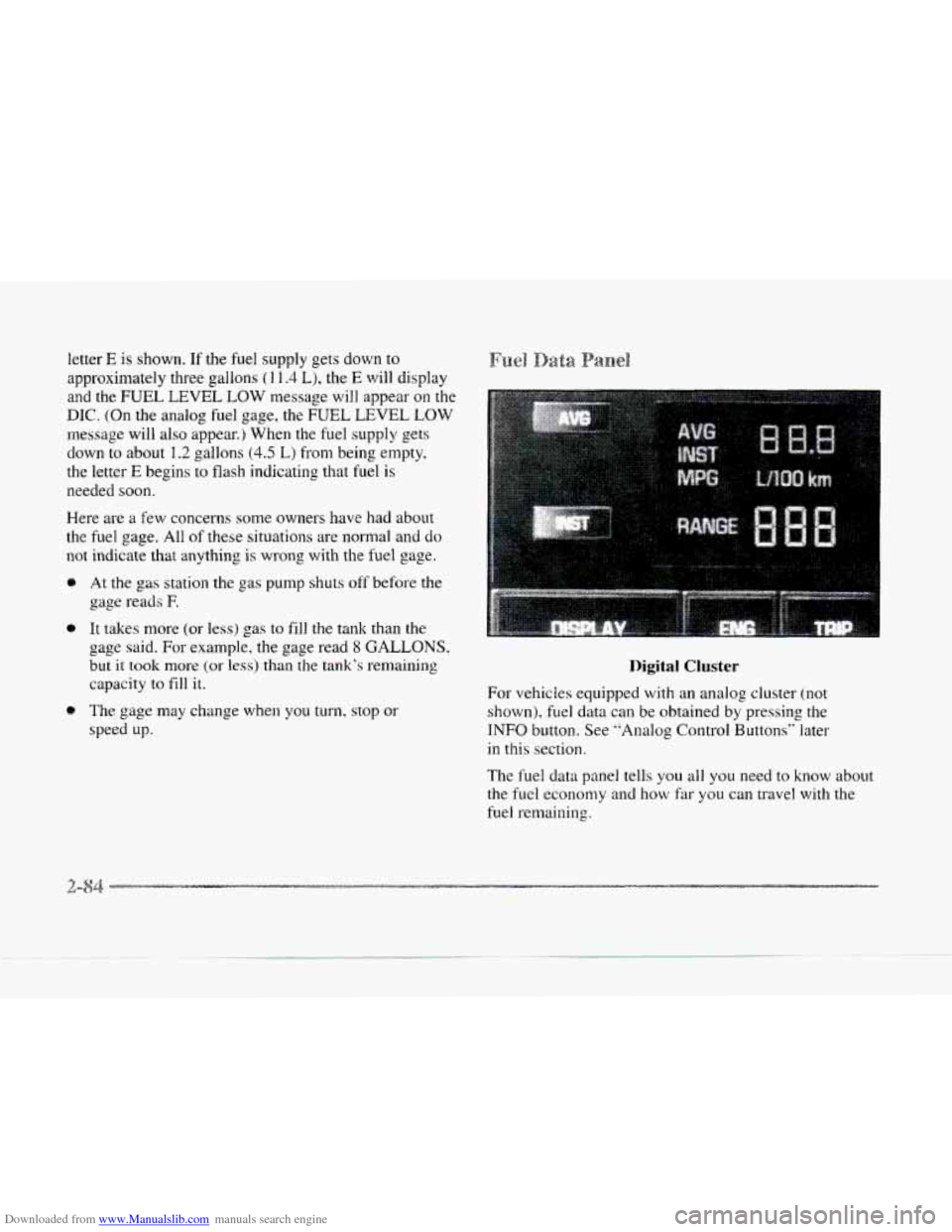
Downloaded from www.Manualslib.com manuals search engine letter E is shown. If the fuel supply gets down to
approximately three gallons ( I 1.4 L), the E will display
and the FUEL LEVEL
LOW message will appear on the
DIC. (On the analog fuel gage, the FUEL LEVEL LOW
message will also appear.) When the fuel supply gets
down
to about 1.2 gallons (4.5 L) from being empty,
the letter
E begins to flash indicating that fuel is
needed soon.
Here are
a few concerns some owners have had about
the fuel gage. All of these situations are normal and
do
not indicate that anything is wrong with the fuel gage.
@ At the gas station the gas pump shuts off before the
gage
reads E
It takes more (or less) gas to fill the tank than the
gage said.
For example, the gage read 8 GALLONS,
but it took more (or less) than the tank’s remaining
capacity to
fill it.
0 The gage may change when you turn, stop or
speed up.
Digital Cluster
For vehicles equipped with an analog cluster (not
shown), fuel data can be obtained by pressing the
INFO button. See ”Analog Control Buttons” later
in this section.
The fuel
data panel tells you all you need to know about
the fuel econonly
and how far you can travel with the
fuel remaining.
Page 221 of 370

Downloaded from www.Manualslib.com manuals search engine Run your engine only as long as you must. This saves
fuel. When you
run the engine, make it go a little faster
than just idle. That is, push the accelerator slightly. This
uses less fuel ’for the heat that
you get and it keeps the
battery charged.
You will need a well-charged battery to
restart the vehicle, and possibly for signaling later on
with your headlamps. Let the heater
run for awhile.
-*- _--
Then, shut the engine off and close the window almost
all the way to preserve the heat. Start the engine again
and repeat this only when you feel really uncomfortable
from the cold. But do it as little as possible. Preserve the
fuel as long as you can.
To help keep warm, you can get
out of the vehicle and do some fairly vigorous exercises
every half hour or
so until help comes.
TIRE-LOADING INFORMATION
VEHICLE CAP. WT.
FRT.
CTR. RR. TOTAL LBS.
MAX. LOADING & GVWR SAME AS VEHICLE
CAPACITY WEIGHT
XXX COLD TIRE
TIRE SIZE SPEED PRESSURE
RTG
PSIiKPa
FRT.
RR.
SPA.
IF TIRES ARE HOT, ADD 4PSIi28KPa
SEE OWNER’S MANUAL FOR ADDITIONAL
INFORMATION
Two labels on your vehicle show how much weight it
may properly carry.
The Tire-Loading Information label
found on the driver’s door tells you the proper size,
speed rating and recommended inflation pressures for
the tires on your vehicle. It also gives you important
information about the number
of people that can be in
your vehicle and the total weight that you can carry.
This weight is called the Vehicle Capacity Weight and
includes the weight
of all occupants, cargo and all
options not installed in the factory.
I
-3
Page 222 of 370
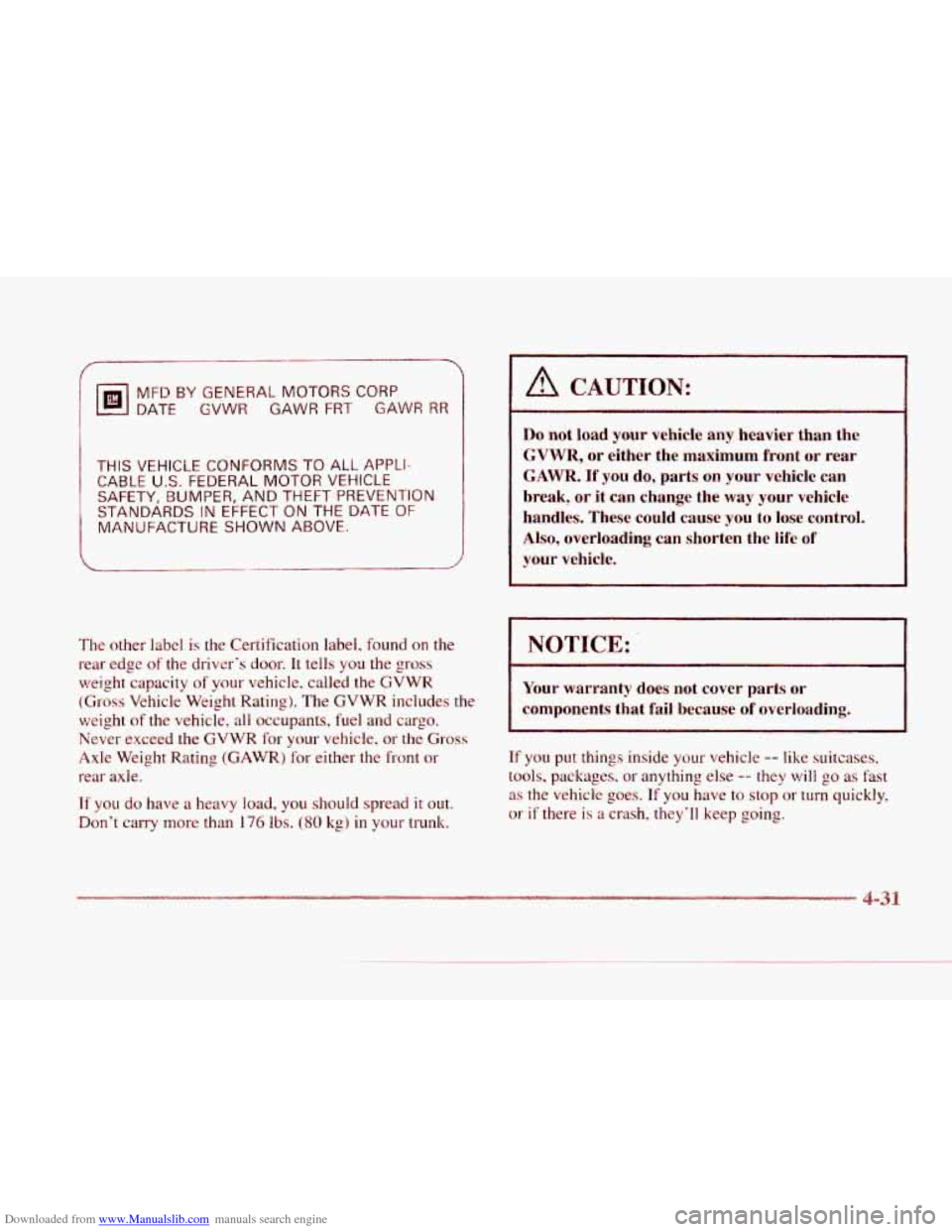
Downloaded from www.Manualslib.com manuals search engine R
c
c
MFD BY GENERAL MOTORS CORP
DATE GVWR GAWR FRT GAWR RR
THIS VEHICLE CONFORMS TO ALL APPLI-
CABLE
U.S. FEDERAL MOTOR VEHICLE
SAFETY, BUMPER,
AND THEFT PREVENTION
STANDARDS
IN EFFECT ON THE DATE OF
MANUFACTURE SHOWN ABOVE.
The other label is the Certification label, found on the
rear edge
of the driver's door. It tells you the gross
weight capacity of
your vehicle, called the GVWR
(Gross Vehicle Weight Rating). The GVWR includes the
weight
of the vehicle, all occupants, fuel and cargo.
Never
exceed the GVWR for your vehicle, or the Gross
Axle Weight Rating (GAWR) for either the front or
rear axle.
If you do have a heavy load, you should spread it out.
Don't carry more than 176 lbs.
(80 kg) in your trunk.
I A CAUTION:
Do not load your vehicle any heavier than the
GVWR, or either the maximum front or rear
GAWR. If you do, parts on your vehicle can
break,
or it can change the way your vehicle
handles. These could cause
you to lose control.
Also, overloading can shorten the life of
your vehicle.
I NOTICE:
Your warranty does not cover parts or
components that fail because of overloading.
If you put things inside your vehicle -- like suitcases,
tools, packages, or anything else -- they will go as fast
as the vehicle
goes. If you have to stop or turn quickly,
or if there is a crash, they'll keep going.
Page 224 of 370

Downloaded from www.Manualslib.com manuals search engine c
Your vehicle can tow a trailer if it is equipped with the
proper trailer towing equipment.
To identify what the
vehicle trailering capacity is for your vehicle, you
should read the information in “Weight of the Trailer”
that appears later in this section. But trailering is
different than just driving your vehicle
by itself.
Trailering means changes in handling, durability and
fuel economy. Successful, safe trailering takes correct
equipment, and it has
to be used properly.
That’s the reason for this part. In
it are many
time-tested. important trailering tips and safety rules.
Many of these are important for your safety and that
of
your passengers. So please read this section carefully
before
you pull a trailer.
Load-pulling components such as the engine, transaxle,
wheel assemblies and tires are forced to work harder
against the drag
of the added weight. The engine is
required to operate at relatively higher speeds and under
greater loads, generating extra heat. What’s more, the
trailer adds considerably to wind resistance, increasing
the pulling requirements.
If You Do Decide To Pull A Trailer
If you do, here are some important points:
0
0
0
0
There are many different laws, including speed limit
restrictions, having
to do with trailering. Make sure
your rig will be legal, not only where you live but
also where
you’ll be driving. A good source for this
information can be state
or provincial police.
Consider using a sway control. You can
ask a hitch
dealer about sway controls.
Don’t tow a trailer at all during the first
1,000 miles
(1 600 krn) your new vehicle is driven. Your engine.
axle or other parts could be damaged.
Then, during the first
500 miles (800 km) that you
tow a trailer, don’t drive over 50 mph (80 Wh) and
don’t make
starts at full throttle. This helps your
engine and other parts
of your vehicle wear in at the
heavier loads.
Obey speed limit restrictions when towing a trailer.
Don’t drive faster than the maximum posted speed
for trailers (,or no more than
55 mph (90 km/h)) to
save wear on your vehicle‘s parts.
4-33
Page 272 of 370
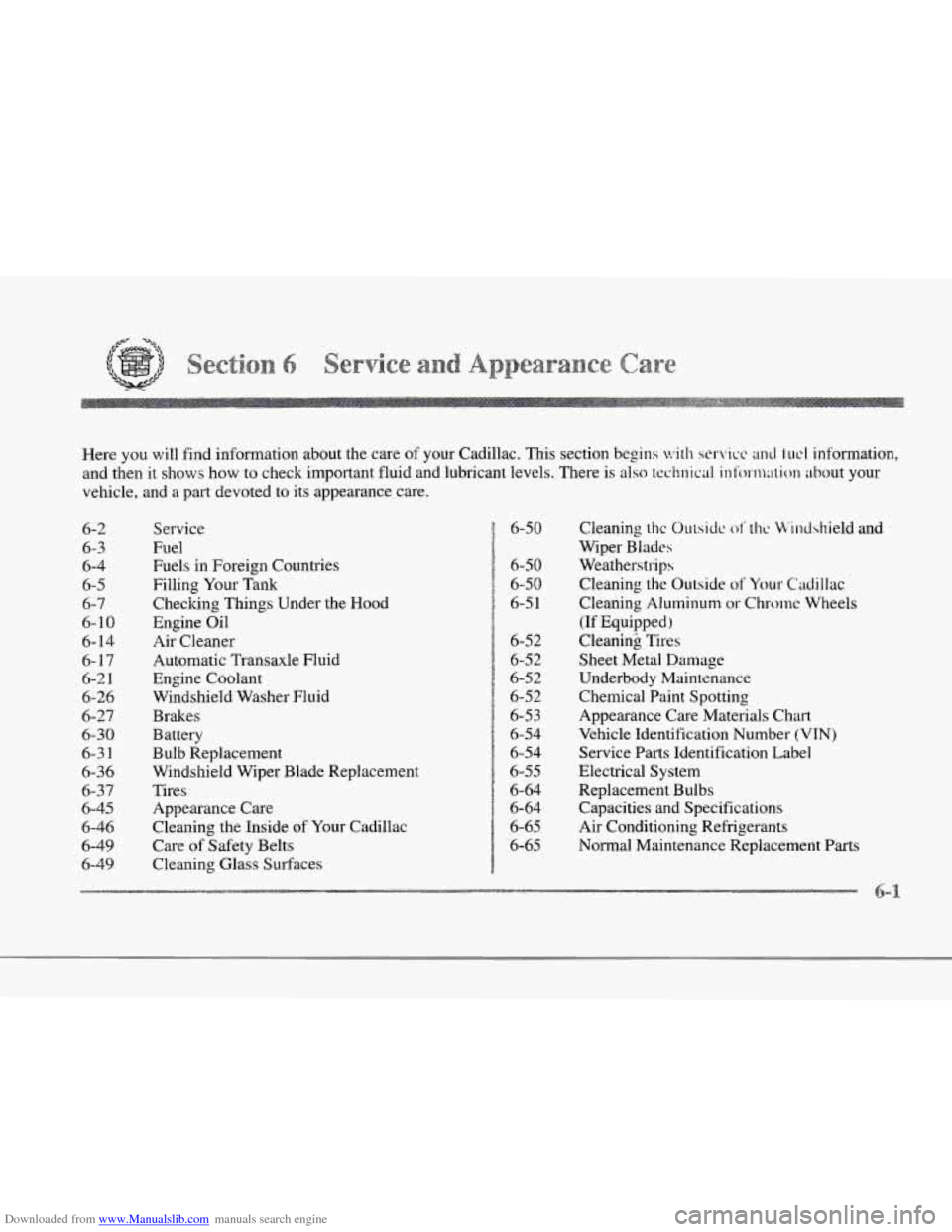
Downloaded from www.Manualslib.com manuals search engine r
r
r
r
r
r
r
Here you will find information about the care of your Cadillac. This section begins with servicc and fucl information,
and then it shows how to check important fluid and lubricant levels. There is also
technical in1i)m;ttion about your
vehicle, and
a part devoted to its appearance care.
6-2
6-3
6-4
6-5
6-7
6-1
0
6- 14
6-17
6-2
I
6-26
6-27
6-30
6-3
1
6-36
6-37
6-45
6-46
6-49 6-49
Se.rvice
Fuel
Fuels in Foreign Countries
Filling Your Tank
Checking Things Under the Hood
Engine Oil
Ais Cleaner
Automatic Transaxle Fluid
Engine Coolant
Windshield Washer Fluid
Brakes
Battery Bulb Replacement
Windshield Wiper Blade Replacement
Tires
Appearance Care
Cleaning the Inside
of Your Cadillac
Care
of Safety Belts
Cleaning Glass Surfaces
6-50
6-50
6-50
6-5 1
6-52
6-5
2
6-52
6-52
6-5 3
6-54 6-54
6-55 6-64
6-64
6-65
6-65
Cleaning thc Oulside of thc b’indshield and
Wiper Blades
Weatherstrips Cleaning the Outside
of Your Cadillac
Cleaning Aluminum or
Chrome Wheels
(If Equipped)
Cleanink Tires
Sheet Metal Damage
Underbody Maintenance
Chemical Paint Spotting
Appearance Care Materials Chart
Vehicle Identification Number
(VIN)
Service Parts Identification Label
Electrical System Replacement Bulbs Capacities and Specifications
Air Conditioning Refrigerants
Normal Maintenance Replacement
Parts
Page 276 of 370
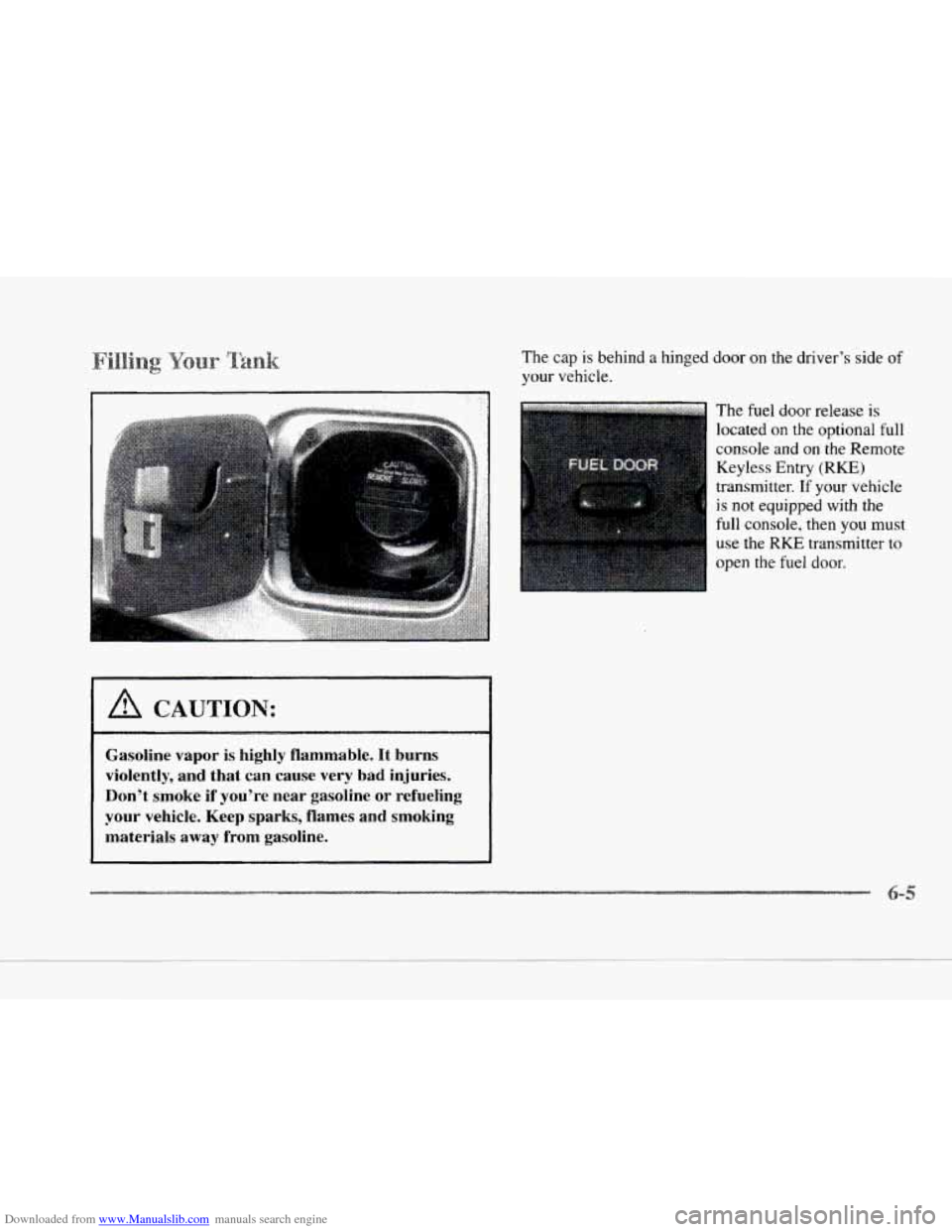
Downloaded from www.Manualslib.com manuals search engine . ..
Gasoline vapor is highly flammable. It burns
violently, and that can cause very bad injuries.
Don’t smoke
if you’re near gasoline or refueling
your vehicle. Keep sparks, flames and smoking
materials away from gasoline.
The cap is behind a hinged door on the driver’s side of
your vehicle.
located
on the optional full
console and on the Remote
Keyless Entry
(RISE)
transmitter. If your vehicle
is
not equipped with the
full console, then you must
use the RKE transmitter to
open the fuel door.
Page 277 of 370
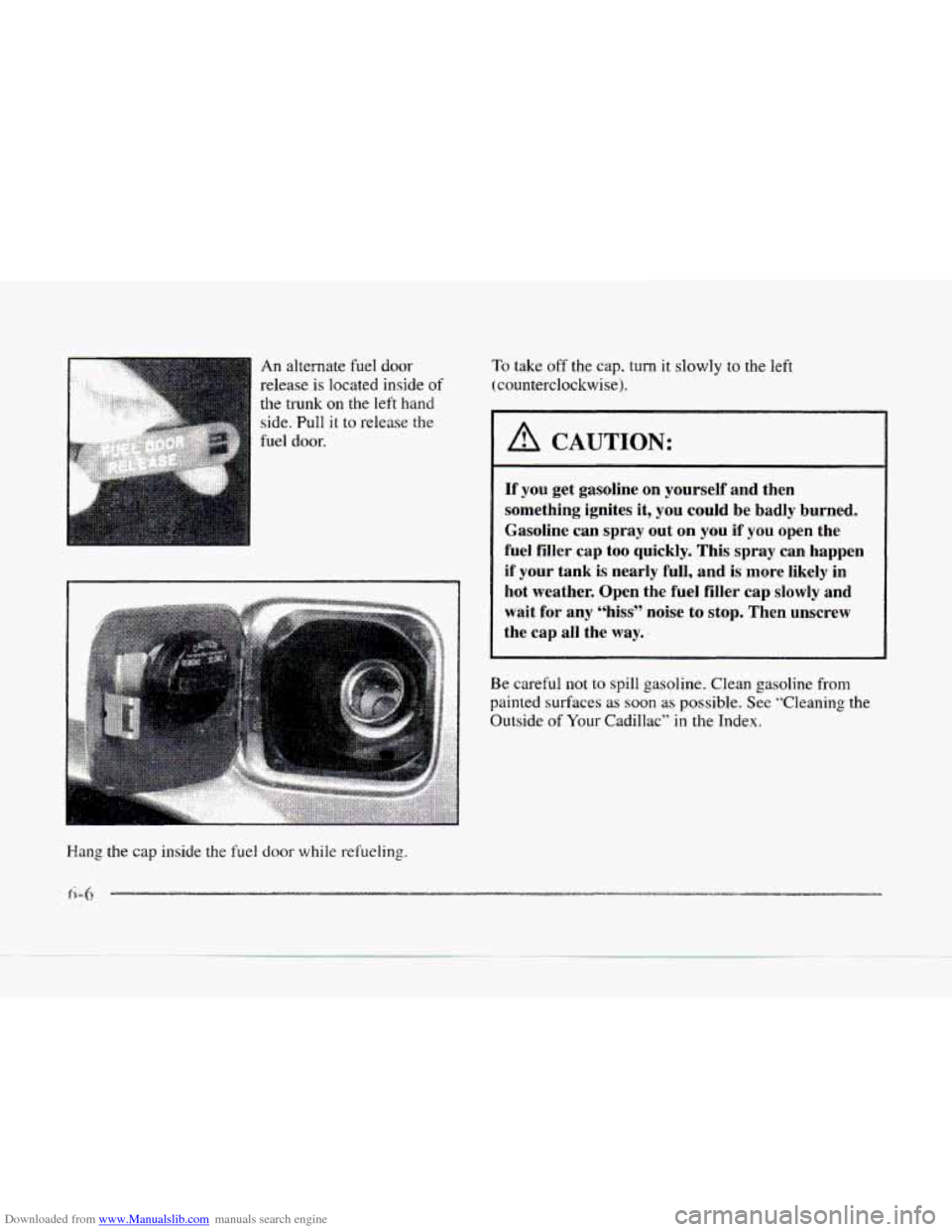
Downloaded from www.Manualslib.com manuals search engine An alternate fuel door
release is located inside of
the trunk on the left hand
side.
Pull it to release the
fuel door.
To take off the cap, turn it slowly to the left
(counterclockwise).
I A CAUTION:
If you get gasoline on yourself and then
something ignites it, you could be badly burned.
Gasoline can spray out
on you if you open the
fuel filler cap too quickly. This spray can happen
if your tank is nearly full, and
is more likely in
hot weather. Open the fuel filler cap slowly and
wait for any “hiss” noise
to stop. Then unscrew
the cap
all the way.
Be careful
not to spill gasoline. Clean gasoline from
painted surfaces as soon
as possible. See “Cleaning the
Outside
of Your Cadillac” in the Index.
Hang the cap inside the
fuel door while refueling.
--
I
Page 278 of 370
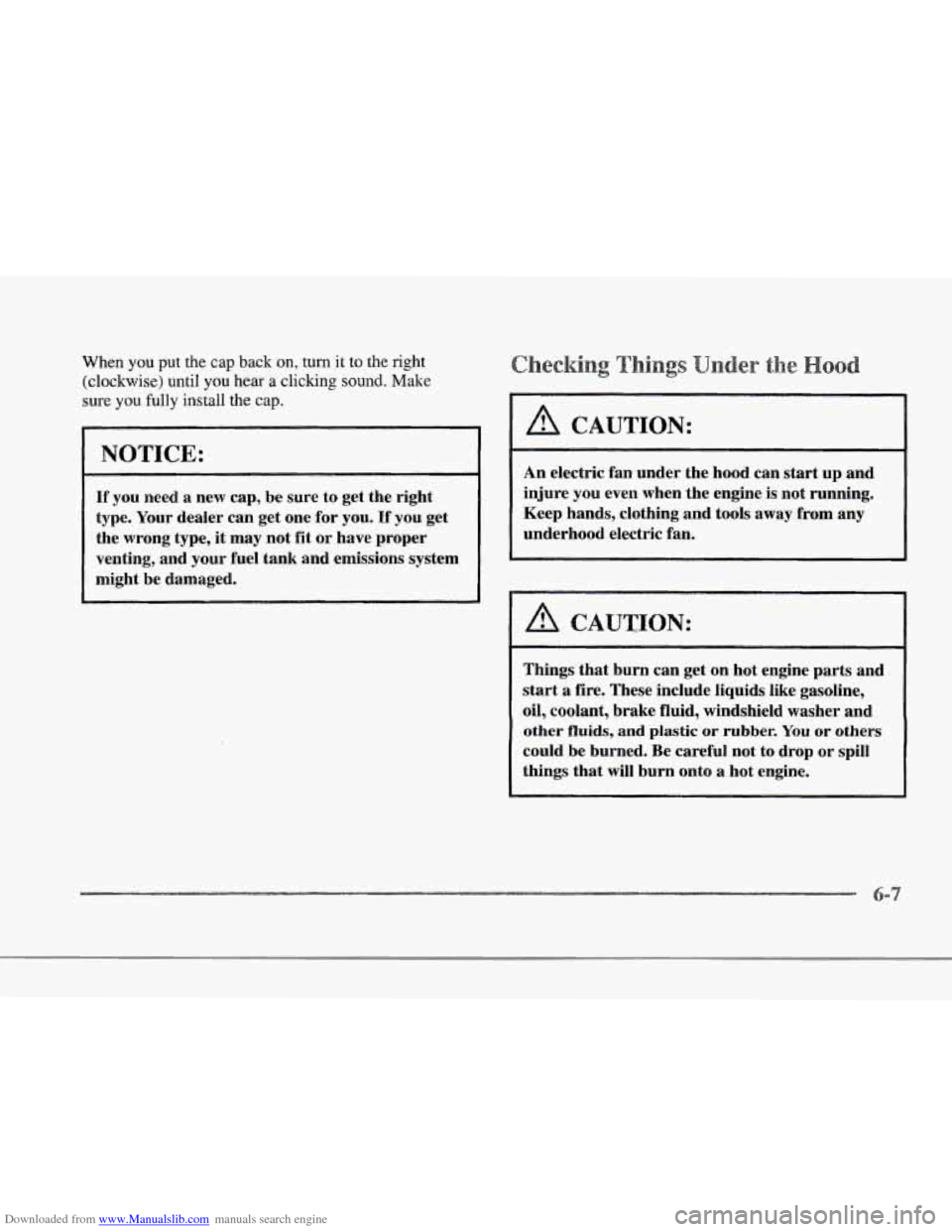
Downloaded from www.Manualslib.com manuals search engine r
f
When you put the cap back on, turn it to the right
(clockwise) until you hear a clicking sound. Make
sure
you fully install the cap.
If you need a new cap, be sure to get the right
type. Your dealer can get one for you.
If you get
the wrong type, it may not
fit or have proper
venting, and your fuel tank and emissions system
might be damaged.
r
r
r
r
IP
A CAUTION:
An electric fan under the hood can start up and
injure you even when the engine is not running.
Keep hands, clothing and tools away from any
underhood electric fan.
A CAUTION:
Things that burn can get on hot engine parts and
start a fire. These include liquids like gasoline,
oil, coolant, brake fluid, windshield washer and
other fluids, and plastic or rubber. You or others
could be burned. Be careful not to drop
or spill
things that will burn onto a hot engine.
Page 335 of 370

Downloaded from www.Manualslib.com manuals search engine Number Application
Headlamps Composite Inner High Beam
....................... 9005
Outer
Low Beam ....................... 9006
Front Turn Signal
..................... 2357 NA
Rear Turn Signal and Taillamp ............. 2057
Engine Specifications
Displacement ......... 279 cubic inches (,4.565 cc)
Type
......................... 4.6 L DOHC V8
VIN Engine Code
SLS .................................... Y
STS .................................... 9
Horsepower
SLS ................... 275 (bhp) 0 5600 rpm
205 (kW) 0 5600 rpm
STS .................... 300 (bhp) @ 6000 rprn
224 (kW) 0 6000 rpm Torque
SLS .................. 300 (lb-ft) @ 4000 rpm
407 (N-rn) (n., 4000 rpm
STS .................. 29.5 ( 113-f’t I Cfa 4300 rprn
400 ( N.m 1 Cl: 4400 rpm
Firing Order ................... j...~..7-.~.-~-~-(~-fj -
Thermostat
Starts To Open . . 177- I8-tc F (8 1 -SS:’Cj
Capacities
Please refer to “Recommended F1 LI ids and
Lubricants” in your Maintenance Sched~rle bookie1
for more information.
Transaxle
(4T80-E) ............ 15 quarts ( 14.2 L)
Crankcase (Engine Oil with
Filter Change)
............. 7.0 quarts (6.62 L)
Engine Cooling System ....... 12.5 quarts ( 1 1.8 L)
Fuel Tank .................. 20 gallons (75.7 L)
R- 134a Refrigerant
............. 2.0 lbs. (0.9 1 kg)
6-64
-_